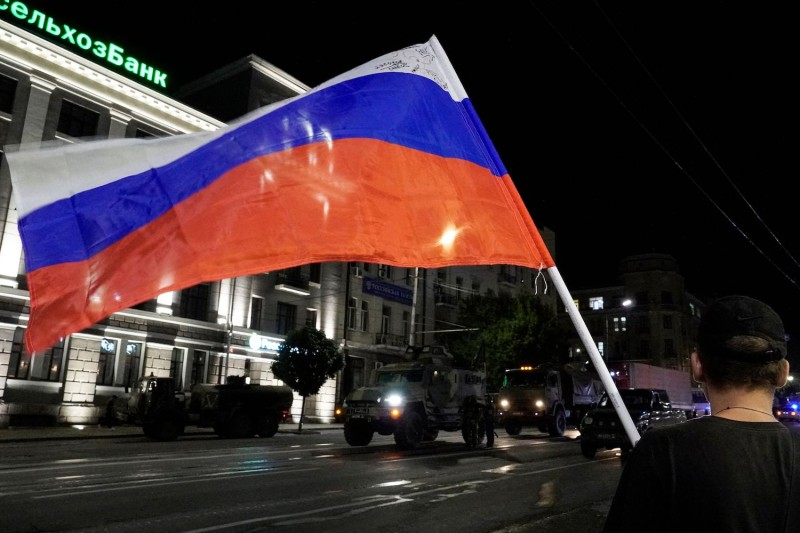
Nobody in Russia understands what the war in Ukraine is about. And now, nobody knows if that war is coming to them.
When I saw the first images of armed men in ragtag uniforms taking over the Russian city of Rostov-on-Don on Saturday morning, I was immediately reminded of the “little green men” who began showing up in cities in Crimea and eastern Ukraine in 2014. Like the Russian troops and soldiers-of-fortune who began the Kremlin’s covert invasion of Ukraine, the fighters in Rostov displayed no insignia as they seized key buildings, including the headquarters of Russia’s Southern Military District. Just as in Ukraine nine years ago, there was no resistance from local law enforcement officers, who chose life over a fight with determined gunmen.
This weekend’s lightning takeover of Rostov by the Wagner mercenary group was the first step in an armed mutiny led by Yevgeny Prigozhin, the ex-con who rose to become Russia’s most infamous battlefield commander. From there, the Wagner forces began a march on Moscow until Prigozhin abruptly ordered his men to turn around and return to their bases. In the space of 24 hours, the full madness of Vladimir Putin’s dictatorship was on display. The blowback of his attack on Ukraine was symbolized by a Wagner tank, marked with the letter “Z,” which stands for the Kremlin’s war effort, pointing not at Ukrainians but other Russians.
Prigozhin said his beef was with the military leadership, which he accused of trying to destroy the Wagner Group. He has a history of publicly insulting Russia’s defense minister, Sergei Shoigu, and the chief of the general staff, Valery Gerasimov, and getting away with it. But Prigozhin’s open show of arms on Russian soil sent a challenge to the Kremlin that Putin could no longer ignore. In a televised address, the Russian president called Wagner’s mutiny a “stab in the back” and warned of civil war. Putin even invoked the violent collapse of the Russian Empire in World War I, though he did not mention Tsar Nicholas II, the disgraced ruler murdered by Russian revolutionaries.
There is another similarity to World War I that Putin did not mention: corruption and incompetence in the Russian military, as well as the inhumane treatment of its own soldiers. Anger with Russia’s top brass has not been limited to Wagner, and Prigozhin’s rage may well extend to the ranks of the Russian military. At the very least, that Prigozhin’s army was able to travel hundreds of miles unhindered shows that the Kremlin lacks the wherewithal to put down a domestic rebellion, especially when its best troops are fighting in Ukraine.
Despite the drama of the situation, a mutiny by Russia’s scariest people should not come as a surprise. The Kremlin allowed Prigozhin to recruit in prisons, which filled Wagner’s fighting force with desperate convicts. Prigozhin has long been the Kremlin’s man for dirty deeds, from interfering in the 2016 U.S. presidential election with his so-called troll farm to fighting undercover in Ukraine, Syria, and the Central African Republic. The Kremlin could deny any connection to Prigozhin, and Prigozhin, of course, denied hiring trolls and warriors. When an unknown number of Wagner contractors in Syria were killed by U.S. forces in 2018, the Kremlin response was muted, since officially they were not members of Russia’s armed forces.
It’s likely that Putin originally imagined Wagner as a Russian version of Blackwater, the U.S. private military contractor that came to prominence in the Iraq War. Wagner mercenaries in Syria and Africa played the part, wearing baseball caps and wraparound sunglasses while toting serious guns. When Russia launched its full-scale invasion of Ukraine last year, Prigozhin stepped out of the shadows to claim ownership of Wagner—and credit for its costly victories. A sledgehammer became the unofficial symbol of the Wagner Group after Prigozhin said one of his fighters had been executed with the tool as punishment for switching to the Ukrainian side.
For Putin, the Wagner mutiny is a self-inflicted wound, the result of his suicidal war against Ukraine. Putin could have chosen to stay on the track of a middle-income economy, with oil and gas exports to Europe guaranteeing enough money to sate his cronies, repress his enemies, and keep the rest of the country quiet, if not happy. Yet the longer he stayed in power, the less interested Putin became in being remembered simply as the leader who stabilized Russia after the collapse of the Soviet Union. That was not enough. Putin wanted the legacy of restoring an empire, beginning with Ukraine.
At first, the mission of the “little green men” he sent into eastern Ukraine was to turn the country into a failed state by embroiling it in a perpetual, low-level war. But Ukrainians defied Russia, and even after the 2022 invasion, they rallied to their country’s defense and did not let it collapse. Though battered and bloodied, Ukraine is unified and clear about its purpose. Now Russia looks like the failed state. Nobody in Russia understands what the war in Ukraine is about. And after Prigozhin’s rebellion, nobody knows if that war might not still come to Russia. Who will defend Putin? And who will go for Prigozhin?
Under an agreement brokered by Belarusian leader Alexander Lukashenko, charges against Prigozhin will be dropped, and he will be allowed safe passage to Belarus. But the deal hardly eliminates the threat that Prigozhin—or someone like him—poses to the Kremlin in the future. It is unclear if we are witnessing the beginning, middle, or end of Putin’s end. What is certain is that it is the final chapter of his rule.
